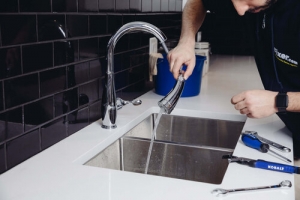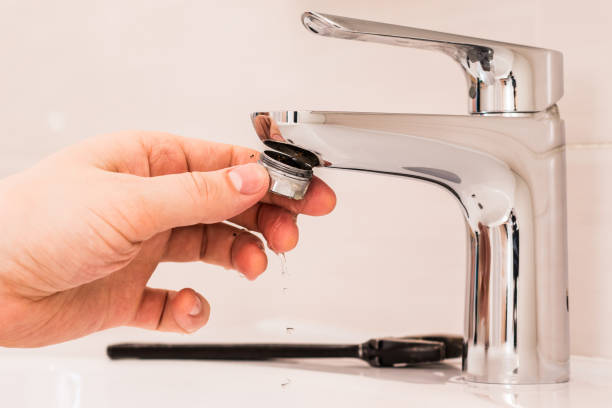What are your thoughts regarding Why It's Important to Fix Leaky Faucets?

Leaking taps may feel like a minor hassle, but their effect goes beyond just the inconvenience of the audio. From wasting water to sustaining unnecessary financial costs and wellness dangers, ignoring a leaking faucet can result in numerous consequences. In this write-up, we'll look into why it's vital to resolve this typical home issue quickly and properly.
Wastage of Water
Environmental Influence
Trickling taps add considerably to water wastefulness. According to the Environmental Protection Agency (EPA), a solitary tap trickling at one drip per secondly can waste more than 3,000 gallons of water per year. This not just strains water sources but likewise affects ecosystems and wild animals depending on them.
Financial Expenses
Raised Water Costs
Past the environmental effect, leaking taps can inflate water expenses substantially. The built up waste in time translates right into greater energy costs, which might have been avoided with timely repair services.
Possible Residential Or Commercial Property Damages
Moreover, long term trickling can cause harm to components and surface areas surrounding the tap. Water build-up can trigger discoloration, corrosion, and even architectural issues if left neglected, leading to added repair work costs.
Health and wellness Issues
Mold and Mildew Growth
The continuous visibility of moisture from a dripping tap creates an ideal atmosphere for mold and mold development. These fungi not just endanger interior air top quality but additionally posture wellness dangers, particularly for people with respiratory problems or allergic reactions.
Waterborne Conditions
Stationary water in dripping taps can come to be a breeding place for bacteria and other virus, increasing the risk of waterborne diseases. Contaminants such as Legionella germs grow in stagnant water, potentially leading to severe ailments when consumed or breathed in.
Do it yourself vs. Expert Repair service
Pros and Cons of Do It Yourself Repair Service
While some may attempt to repair a leaking faucet themselves, do it yourself repair services include their own collection of challenges. Without appropriate expertise and devices, do it yourself attempts can intensify the issue or cause incomplete fixings, extending the trouble.
Benefits of Hiring a Specialist Plumber
Employing a specialist plumber makes sure that the underlying cause of the leaking faucet is attended to properly. Plumbing professionals have the know-how and tools to identify and fix faucet issues effectively, conserving time and decreasing the risk of additional damage.
Step-by-Step Overview to Taking Care Of a Dripping Faucet
Devices Required
Before attempting to repair a trickling faucet, gather the essential devices, consisting of a flexible wrench, screwdrivers, substitute components (such as washing machines or cartridges), and plumber's tape.
Common Tap Issues and Their Solutions
Determine the type of faucet and the particular issue creating the drip. Common troubles include worn-out washing machines, rusty shutoff seats, or faulty O-rings. Refer to supplier directions or online tutorials for step-by-step assistance on repair services.
Preventive Measures
Normal Maintenance Tips
To stop trickling taps, execute regular maintenance such as cleansing aerators, inspecting for leakages, and changing damaged parts promptly. Furthermore, think about installing water-saving tools or upgrading to a lot more effective fixtures.
Value of Prompt Services
Attending to trickling faucets as quickly as they're discovered avoids additional water waste and prospective damage, ultimately conserving both water and money over time.
Influence On Residential Or Commercial Property Value
Assumption of Well-Maintained Residential Property
Keeping a residential or commercial property in good condition, consisting of addressing maintenance issues like trickling taps, boosts its viewed worth and charm amongst prospective purchasers or occupants.
Influence on Resale Worth
Characteristics with properly maintained plumbing components, consisting of taps, command higher resale values in the realty market. Addressing leaking taps can add to a positive impression throughout residential property assessments and arrangements.
Ecological Responsibility
Private Contribution to Conservation
Taking duty for dealing with leaking faucets lines up with wider initiatives towards water preservation and environmental sustainability. Every individual's actions jointly make a significant influence on maintaining priceless sources.
Lasting Living Practices
By prioritizing prompt repair work and taking on water-saving behaviors, people add to lasting living practices that benefit both present and future generations.
Conclusion
Resolving a leaking tap goes beyond mere benefit; it's a vital action towards saving water, lowering financial costs, and securing wellness and residential property. Whether via DIY repair work or expert aid, taking action to repair trickling taps is a tiny yet impactful means to promote liable stewardship of resources and contribute to a healthier, more lasting future.
How to Fix a Leaky Faucet: Step-by-Step Repair Guide
A leaky faucet may seem like a simple annoyance, but if it's not fixed promptly, that leak could cost hundreds to potentially thousands. From water damage to mold, mildew, and high water bills, even a tiny leak can be catastrophic if left unattended. Damage like this can even affect the overall value of your home, so it's important to take the right approach for leaky faucet repair. You may need the help of a plumber in some cases, but we've got a few tips you can try on how to fix a leaky faucet before calling the pros.
Four Faucet Types
When you're learning how to fix a leaky faucet, the first step is knowing what kind of faucet you're working with! There are four common types.
Cartridge Faucets
Cartridge faucets come in one- or two-handled varieties. In one-handled cartridge faucets, hot and cold water combines in a single cartridge. In the two-handled versions, hot and cold water are controlled separately and mixed in the faucet.
Ball Faucets
Ball faucets have a single lever you push up and down to adjust the pressure and rotate to change the temperature. A slotted metal ball controls the amount of water allowed into the spout.
Compression Washer Faucets
They're the oldest type of faucet, but they're still used in many homes — especially older ones. Compression faucets have two separate handles that, when turned, raise or lower the washer that seals a water valve. This valve stops water from flowing through the faucet when it is turned off.
Disc Faucets
Disc faucets rarely need to be repaired due to their maintenance-free design. The water flow is controlled by two discs — the upper one raises and lowers against a fixed lower disc, creating a watertight seal. If your disc faucet starts leaking, you may need to replace the seals or clean residue buildup from the inlets.
Fixing a Leaky Faucet
Step 1: Turn Off the Water
Whether you're learning how to fix a leaky bathtub faucet or how to fix a leaky kitchen faucet, always turn off the water supply to your working area when you're fixing a leak. The last thing you want is a flood added to your list of things to fix.
Look for the shutoff valves below your sink or around the tub and turn them clockwise to stop the water flow. If your faucet doesn't have shutoff valves, you may need to turn off the water for the whole house. Check to make sure it's off by turning the faucet on. If nothing comes out, you're ready to start the repair.
Step 2: Take Apart the Faucet
How you disassemble your faucet depends on the type of fixture you have. You can use a flathead screwdriver to remove the caps on top of the handle or handles for cartridge and compression faucets. Inside, you should see handle screws. Unscrew these with a screwdriver to remove the handle.
Disc- and ball-style faucets will typically have an inlet screw near the handle, and removing that will reveal the interior of the faucet.
Detach the Valve Stem
For cartridge- and compression-style faucets, you'll see the inner valve stem or cartridge once you remove the faucet handles. If you have a compression faucet, unscrew the brass valve stem. If you have a cartridge faucet, pull out the cartridge. If your cartridge has been in place for a while, it may require some tools or extra force to remove it due to mineral deposits.
Examine and Replace Parts
Once you've removed the parts, check them out to confirm what needs to be replaced. You may see corroded rubber washers, O-rings, stems, or cartridges. On a ball-style faucet, check the seats and springs for damage.
If you need to repair a leaky disc faucet, check the inlet and seals on the lower disc.
Once you determine what parts must be replaced, visit your local hardware store. Bring the damaged parts with you to ensure you can purchase the correct components to replace them.
Clean Valves and Faucet Cavity
If you've removed a stem or cartridge, you may notice mineral buildup in the faucet's threads. Use white vinegar to clean the valve seat by soaking it for a few minutes, then scrub it away with a soft toothbrush and rinse with warm water. You can also clean the interior of the faucet in the same way.
Reassemble the Faucet
Once your faucet is cleaned and the required parts have been replaced, it's time to reassemble it. Put the pieces back together and slowly turn the water supply back on. Doing this slowly is crucial because too much initial water pressure can damage the new hardware you've just installed.
https://homewarranty.firstam.com/blog/how-to-fix-leaky-faucet

I discovered that review about Leaky Faucets: Why They Happen & What to Do About Them while browsing the internet. I beg you take the time to distribute this post if you enjoyed reading it. We cherish reading our article about What Causes Leaky Faucets & How To Fix Them.
Comments on “Our Motives Behind Fixing a Broken Faucet”